Blog #3: Prototyping
Prototyping

Capture the Cubes is a game of tug of war, where players compete to control all capture points by spawning soldiers and getting resources. The team that has captured all the hexes or is the last color standing wins!\
Mechanics
- Area Control
- Grid Movement
- Dice Rolling
- Player Elimination
First Iteration
The first iteration focused on the usage of action points for all interactions within the game.
Players sought to control all points or eliminate the enemy team. They started with three soldiers on opposite ends of the grid and and played rock paper scissors to determine who went first.
Soldiers had 4 action points and could perform the following.
- Move 2 spaces (2 points)
- Attack with 1 die (2 points)
- Bandage (1 point)
- Add a point to capture a cube (any number of points)
To attack, players could attack any adjacent unit and roll an 8 sided die. If the die was even, the soldier lost one action point. When a soldiers action points reach 0, they are dead.
To capture a point, a soldier needed to donate 6 action points to capture it (on the same tile). Once captured, a soldier could spawn a unit in with 4 action points.
First Session (w/ Matthew Binning)
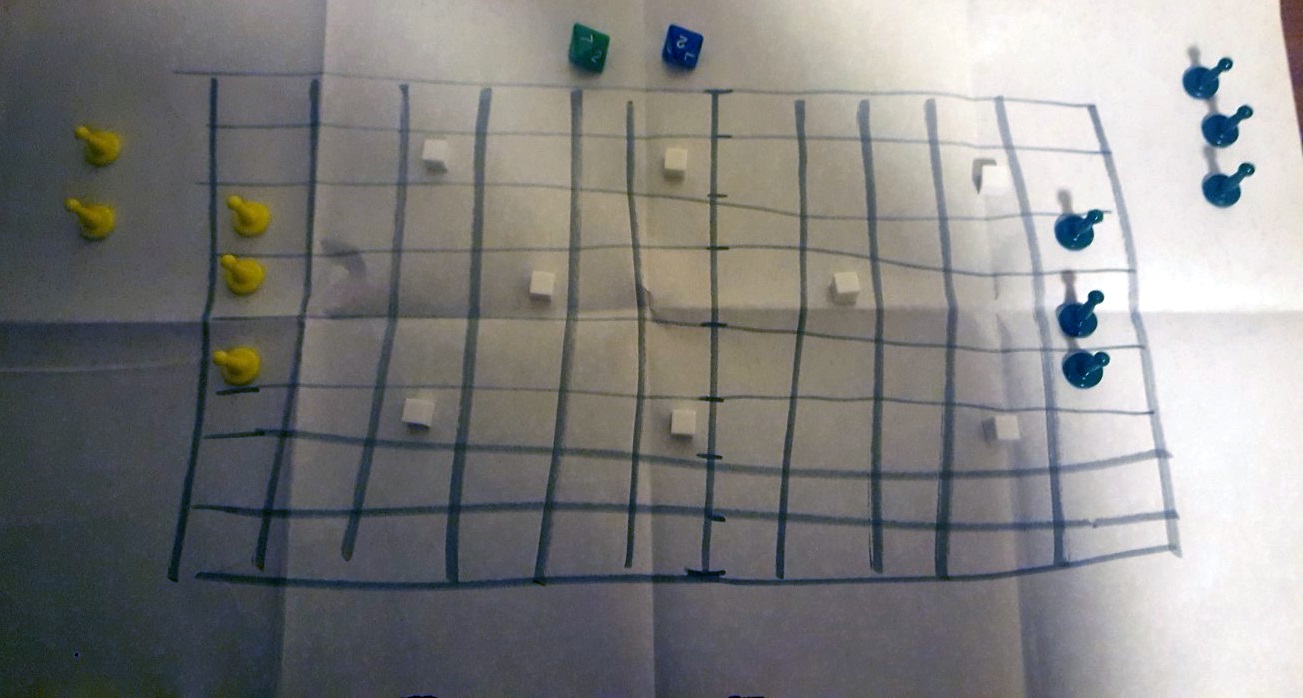
We placed our units on opposite sides of the grid with a cross shape of green resources in the center of the field.
I won the RPS, so I went first.
On my turn, I moved my units straight toward the closest bases, but I didn't have enough AP to reach them.
Matt did the same on his turn.
At this point, we both began capturing bases while our other units clash in the middle, spending points to attack each other.
For example, I spent 4 action points to attack one of his units next to mine, and only one rolled an even, reducing his soldiers points from 3 to 4. This meant his soldier could no longer perform multiple actions.
However, on the next turn the soldier managed to bandage itself by rolling an even number on an 8 sided die, then attacked my soldier and brought my health down to 3.
Unfortunately, several problems emerged from this interaction of mechanics.
- First, it took a long time for soldiers to die unless multiple soldiers were attacking one soldier at a time.
- Second, capturing points was very memory intensive.
- There was no visual indicator to display how many points were donated to a point to capture it.
- For example, one of my units put 2 points into a capture and then left. I forgot this later on in the game, and had to attempt to remember the amount of capture points it needed (4 to make 6).
- Third, we had to remember all the action points of every unit we had, which became increasingly difficult when more were added to the field and the fact that they all look the same!
Finally, we quickly realized that the game would never end. We would spawn soldiers in infinitely and soldiers would never die, and we would endlessly be capturing points for likely an hour before the dice rolls would make someone
Second Iteration
Once I took my copy of the board game home (using red and blue pieces), I decided the most important attribute to change was the action point system. It was too complicated for the nature of the actions and game play going on, and needed to be simplified and streamlined to make a faster paced game.
You can see the rules for the second iteration here.
The changes made include the following:
- The board is smaller and now made of hex tiles (more adjacency, no slow moving diagonal moves)
- Soldiers no longer have action points, instead they can perform two actions every turn
- Move 2 spaces
- Attack an adjacent enemy
- Fully capture a point
- Soldiers cannot move or attack through walls, and can move through friendlies but not enemies
- Players now place 3 units on their team color hex
- Teams start with two hexes already captured (the two closest to their side of the field)
- After capturing a point
- The player takes the resource
- If it is an enemy point, the player takes the enemy's resource
- If the enemy has no resource, the player takes a resource from the pile
- Players now spawn soldiers on the spawn hex
- They can only spawn soldiers by spending a green resource, have soldiers in their reserve, and control three bases
- If a team controls the middle hex, the player can spawn soldiers on the enemy spawn hex at the opposite end of the field
- Soldiers can attack one adjacent soldier by rolling an 8 sided die. If the result is 4 or greater, the soldier is dead and placed in the dead pile
- A soldier in the dead pile cannot be respawned. They are dead for the rest of the game
- The win condition is unchanged
Second Session (w/ Marilyn Guaresti)
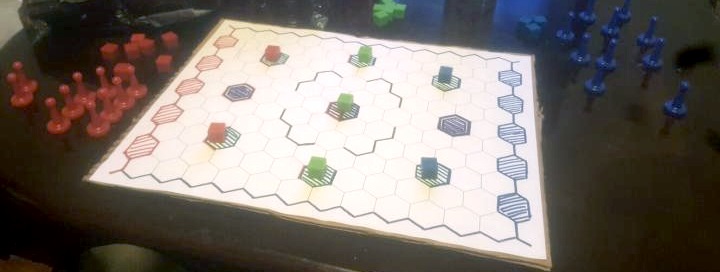
For this play session I was tasked with playing the game with a non-game-designer. This play through was meant to test for "fun"ness, so I decided to test it with my Significant Other.
Before we started playing, she criticized that the game looked boring and complicated. I was unable to get through the rules without some groans and ughs.
We setup our troops on our respective sides ( I blue ) and we realized that with three there was an optimal position to reach the outside cubes. In addition, whoever went first would get the first capture. Therefore, since I went first I captured three points immediately and spawned a soldier.
She was able to fight back on the bottom resource by killing my soldier and stole back my resource, then she spawn her soldier in.
However, the next turn quickly turned sour as I was able to get man successful 4s on my attack rolls, killing nearly all of her units.
Here is where she criticized that a 4+ roll is more than a 50-50, making it likely that soldiers die.
In addition, soldiers cannot defend themselves. They are simply attacked directly and die at the whims of the attacker's roll.
This game ended by her last red unit stranded on the blue side. She moved to capture another point but did not have enough spaces to make it. My soldiers moved into the middle capture point and killed her soldier with only one roll.
On the second playthrough, Marilyn got the more successful rolls this time as she wiped out my units in the middle of the field and spawned up to 6 red troops. I was running for my life across the board attempting to capture points to spawn friendly units in, but it was too late as I was surrounded on the bottom hex point, murdered by multiple dice rolls.
Her final criticism was that the game was aesthetically boring. I think this issue needs to be fix by giving context to the conflict of the game. However, I feel the game is currently limited by the blank board and similar looking units. If there was diversity in the tokens I used or actual models (like scifi soldiers or mechs), it would greatly enhance the feeling of perhaps urban attrition. For example, risk uses simple tokens but the art of the board gives it the context of world conflict.
Third Iteration
The following changes were made in the third iteration:
- Soldiers must roll greater than 4 to eliminate another soldier
- Teams now start with 5 soldiers on all color hexes instead of 3
- Soldiers can defend themselves if they are on top of a same color capture point
- To defend, if the defender rolls higher than the attacker, the soldier lives. If the defender rolls lower, they are eliminated regardless of how high the attacker rolled. (Ex. Defender rolls a 2, attacker rolls a 3. The defender dies)
These changes we made to promote player choice, variety of strategy, longevity of soldier lives, and finally the aesthetic of controlling a squad of soldiers rather than just three.
By having 5 soldiers, players can decided to move in groups or to disperse and chase down the capture points. Or, they could move their soldiers at the initial control points to defend them from attackers, then cautiously capture and push the enemy with spawned units.
Third Session (w/ William Whitehead)
This session exemplified the player who goes first has significant advantage.
I played blue and William played red, and I won the RPS.
Since I go first, I moved all my units to the optimal position to capture on the next turn. Since William went second, it was impossible for him to capture these points without fighting me for it. Once I got the resources, I spawned in two units and had defenders advantage on all three points.
On Williams turn, he decided to defend his points and fight for the top point. One of his units by the red side of the field eliminated my spawned unit.
We fought over the center point throughout the game, but William was getting overwhelmed with all the units I was able to spawn. While he might have killed many of my soldiers throughout the course of the game, I had much greater map control than his units, so he was unable to spawn in new ones.
This control allowed me to prevent him from gaining anymore resources, eventually leaving him trapped with one unit on the field.
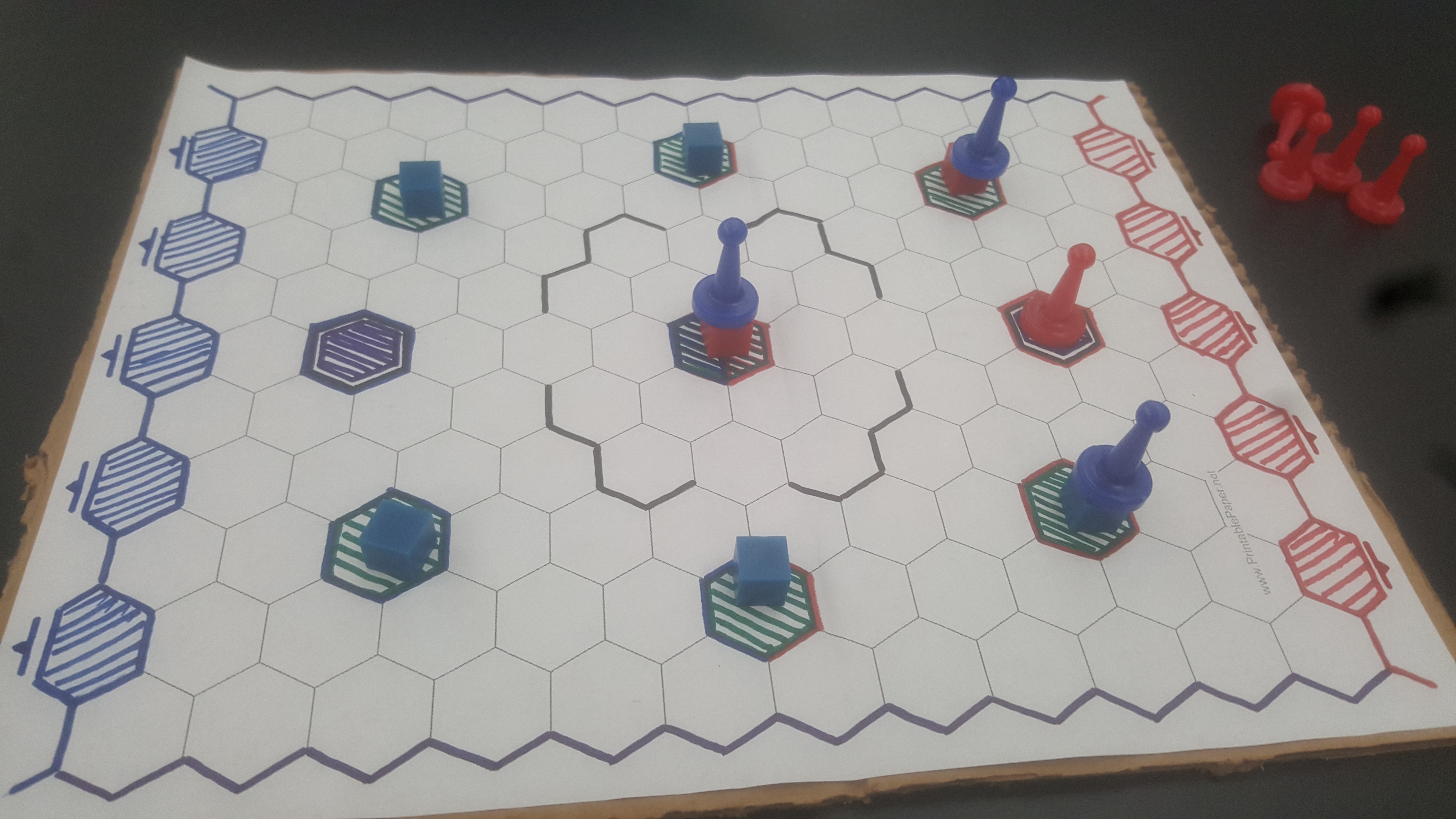
As pictured above, I had control of all of the resources except two, which I had already begun capturing. His only choice left was to fight for the center to get more resources. However, the most pivotal dice roll put my defender on top.
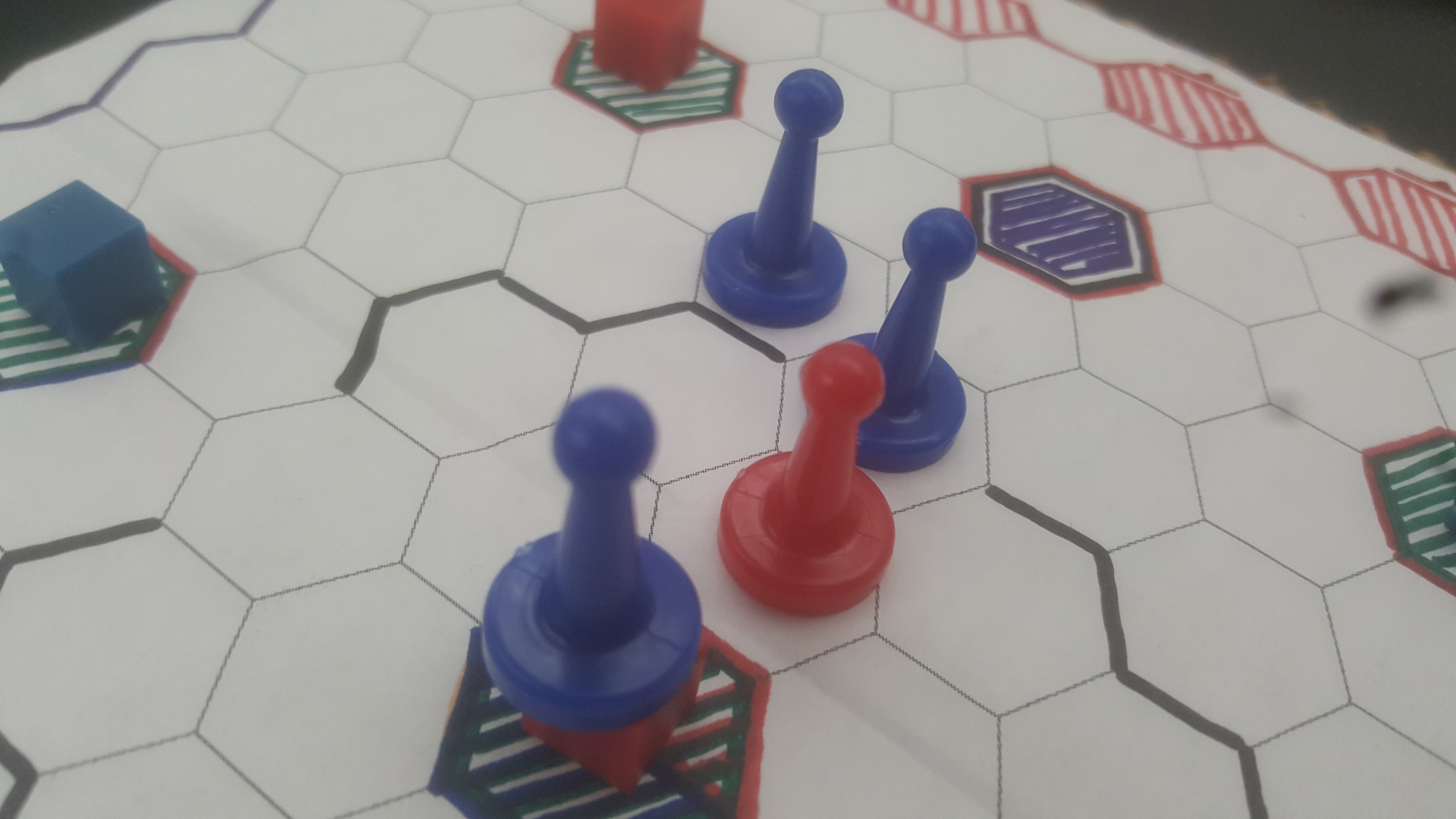
I had him surrounded and used all of my attacks to try an eliminate the last soldier. On my first roll, I got an 8 and won the game.
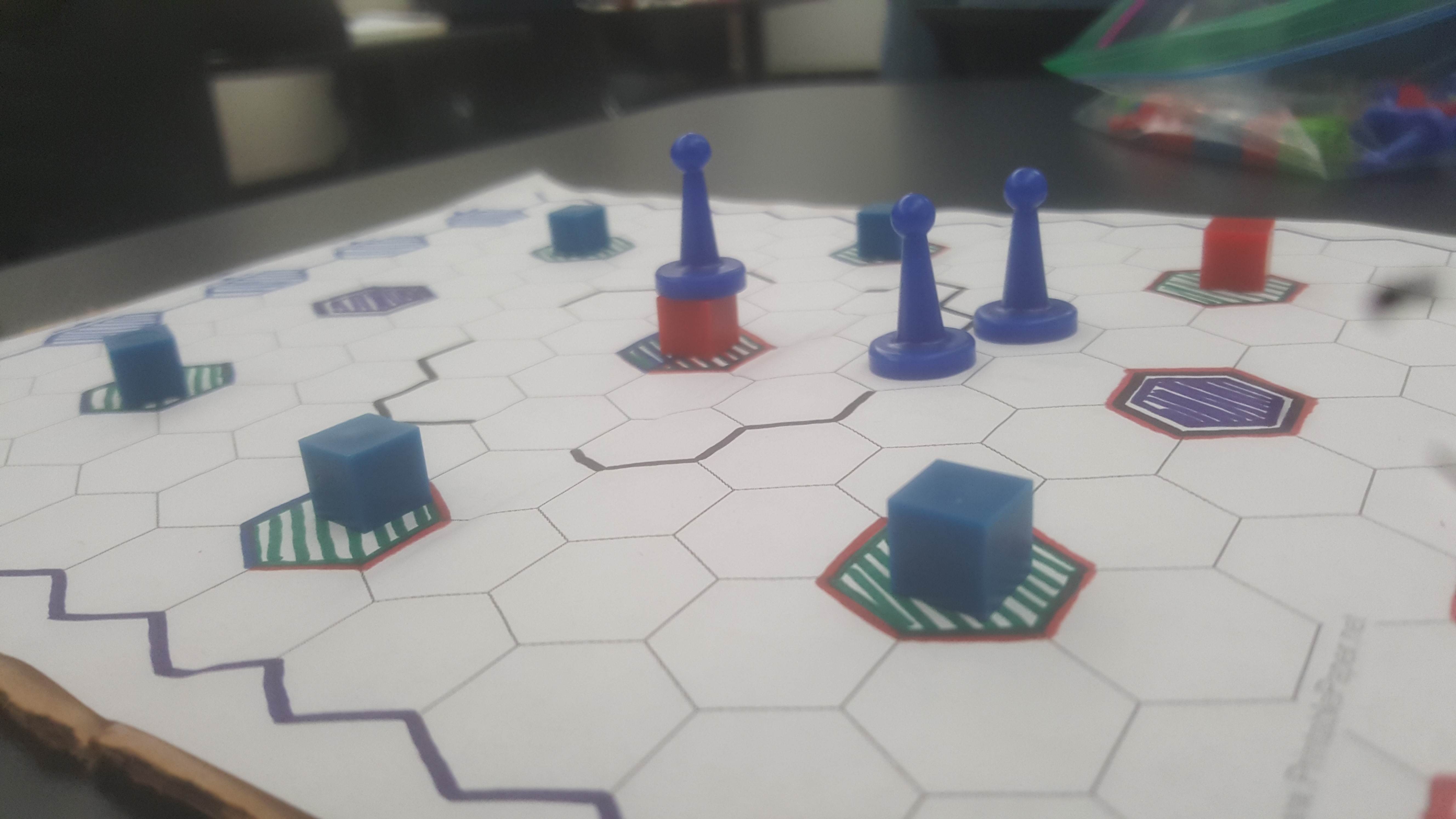
While the game involved some strategy, there is a clear flaw. Whoever goes first will get immediate control over the middle three capture points no matter what. This HAS to change or else the game will never play fair. Especially because the new defense mechanics favors the defender, and if you can capture a point the fastest, you have the optimal strategy.
This is a direct result of the a lack of unit diversity. If different units could attack at different ranges or had different movement abilities, different strategies would arise and the first player advantage would disappear. However, I do not have a variety of models to choose from (only one).
To work within these limits, my last change to this prototype is that whoever loses the initiative test (RPS, dice roll, etc) must move two pieces. Once they have moved, the player with initiative may move all pieces to start the game.
This allows two things to happen:
- The player who lost initiative gets a chance to fight for the center or outside capture cubes
- The player who won initiative can see the losing players strategy when they move their two units and react
- This way, both players get a benefit and no direct first move advantage. Instead, they share it unequally.
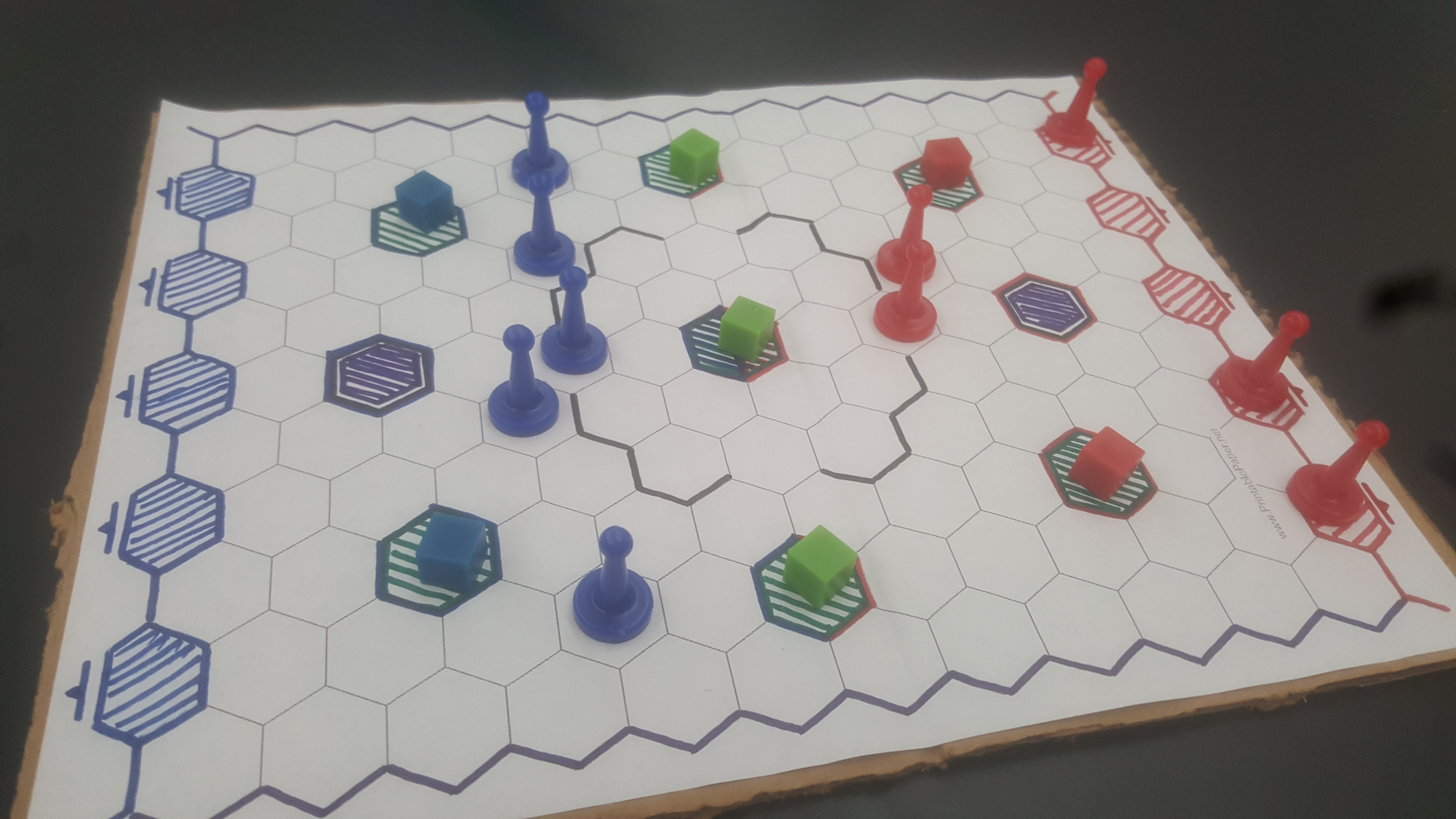
This is an example of the above changes.
- Blue team won advantage
- Red team gets to move two units
- Blue team starts the game by moving all 5
- ... and the game progresses as normal
Thanks for reading this prototype iteration blog!
The rules and instructions to build this game will be included with this blog post and the CS108 downloadable files
Files
Get CS 108 - Game Studies
CS 108 - Game Studies
The blog project for the course CS108 Game Studies with James Morgan at SJSU!
| Status | In development |
| Category | Other |
| Author | Chaz Acheronti |
| Tags | Arcade, course, cs108, Game engine, game-studies, Godot, Local multiplayer, san-jose, sjsu, university |
More posts
- Blog #9: Course ReflectionMay 17, 2018
- Blog #8: Final Game Alpha TestMay 02, 2018
- Blog #7: GPS GameApr 26, 2018
- Blog #6: Video Game PrototypeApr 05, 2018
- Blog #5: Alpha PlaytestingMar 20, 2018
- Blog #4: Video Game LabFeb 27, 2018
- Blog #2: Boardgame Session ReportFeb 08, 2018
- Blog #1: Adopt a Classic Arcade GameJan 27, 2018
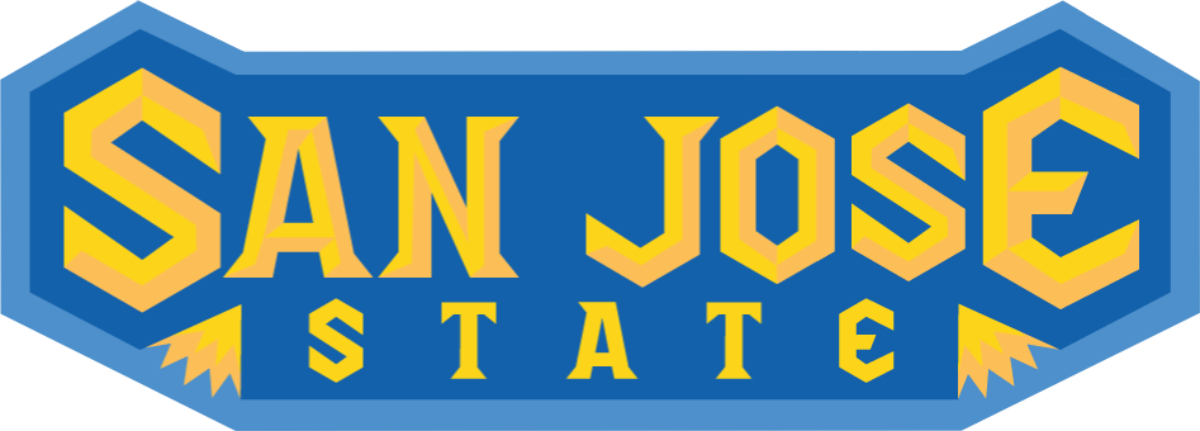
Leave a comment
Log in with itch.io to leave a comment.